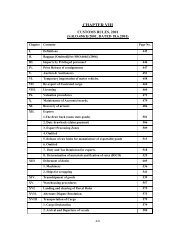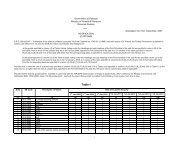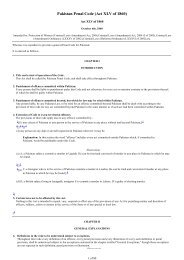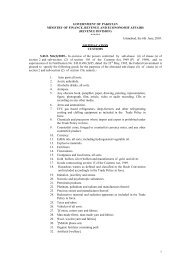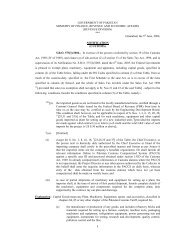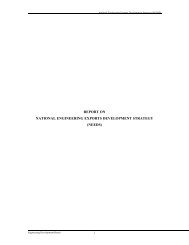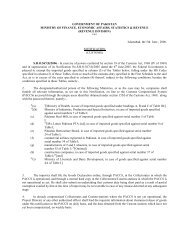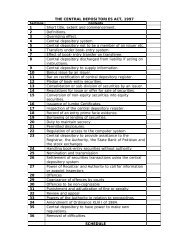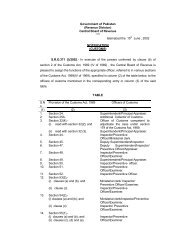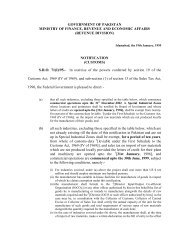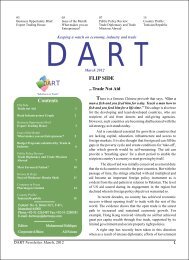47. Pakistan Economic Survey 2011-12 - Consultancy Services in ...
47. Pakistan Economic Survey 2011-12 - Consultancy Services in ...
47. Pakistan Economic Survey 2011-12 - Consultancy Services in ...
Create successful ePaper yourself
Turn your PDF publications into a flip-book with our unique Google optimized e-Paper software.
<strong>Pakistan</strong> <strong>Economic</strong> <strong>Survey</strong> <strong>2011</strong>-<strong>12</strong>of <strong>Pakistan</strong> by 5000 active citizen volunteers throughout <strong>Pakistan</strong>.Box 1ASER <strong>2011</strong> National Summary (RURAL)Enrolment Characteristics In <strong>2011</strong>, 79.9 percent of 6-16 year olds <strong>in</strong> rural <strong>Pakistan</strong> were enrolled <strong>in</strong> schools while 20.1 percent were out ofschool. This number has held steady s<strong>in</strong>ce 2010. Nationally there is a persistent gender gap <strong>in</strong> out of schoolchildren with more girls than boys be<strong>in</strong>g out of school except for the 14-16 age group where slightly more boysare out of school than girls (boys 3.1 percent, girls 2.9 percent) Pre-school enrollment (3-5 years) was 42.8 percent, which is quite close to the overall EFA/National Plan ofAction (NPA) target of 50 percent enrolment <strong>in</strong> pre-school by 2015. The highest enrolment <strong>in</strong> this age groupwas 51.3 percent <strong>in</strong> Punjab and lowest <strong>in</strong> Gilgit-Baltistan (29.4 percent) with majority enrolled <strong>in</strong> governmentschools. For urban areas this trend is highest <strong>in</strong> Karachi (68.9 percent) with majority of children <strong>in</strong> privateschoolsPrivate school enrolment is on the rise: Nationally, non-state private school enrolment stood at 25.5 percent. Highest private school enrolment wasseen <strong>in</strong> Gilgit-Baltistan (43.6 percent) with FATA (40.5 percent) and Punjab (33.2 percent) close beh<strong>in</strong>d Madrasah enrolment <strong>in</strong>creased from 0.9 percent <strong>in</strong> 2010 to 2.1 percent <strong>in</strong> <strong>2011</strong> Accord<strong>in</strong>g to prov<strong>in</strong>cial data, highest Madrasah enrolment was found <strong>in</strong> Balochistan at 6.5 percent while districtwise data show that Bahawalpur had the highest Madrasah enrolment (6.4 percent)No major changes <strong>in</strong> Dr<strong>in</strong>k<strong>in</strong>g Water and Toilet Facilities National figures for <strong>2011</strong> do not show any significant improvement <strong>in</strong> the proportion of schools with useablewater and toilet facilities. Of the total government primary schools surveyed, 55.4 percent had useable waterfacility and 43 percent had a functional toilet In ASER 2010, it was found that 57.5 percent of the government primary schools surveyed had useable waterwhile 45.3 percent had a functional toilet Facilities <strong>in</strong> government schools have improved most <strong>in</strong> Punjab followed by Khyber Pakhtunkhwa (KPK). InPunjab 80 percent government schools have a useable water facility and 70 percent have a functional toiletwhereas <strong>in</strong> KPK 59 percent government schools were found with a useable water facility and 52 percent with afunctional toiletArithmetic Competencies Improved but Basic Read<strong>in</strong>g Levels show a Decl<strong>in</strong>e Like 2010 the ASER <strong>2011</strong> evidence is most worry<strong>in</strong>g on learn<strong>in</strong>g levels across school systems Arithmetic levels have improved: Basic arithmetic levels estimated <strong>in</strong> ASER <strong>2011</strong> show a slight improvement.For example, nationally, the proportion of class 5 children able to solve a 3 digit division problem has <strong>in</strong>creasedfrom 34.3 per cent <strong>in</strong> 2010 to 37.3 per cent <strong>in</strong> <strong>2011</strong>. The improvement is most visible <strong>in</strong> the prov<strong>in</strong>ces ofPunjab, Gilgit-Baltistan and Balochistan. Urdu read<strong>in</strong>g levels are estimated to have decl<strong>in</strong>ed slightly: The proportion of children <strong>in</strong> class 5 able to read aclass 2 level Urdu story text has dropped from 51.6 per cent <strong>in</strong> 2010 to <strong>47.</strong>4 per cent <strong>in</strong> <strong>2011</strong>. Balochistan,however, has shown a visible improvement. The proportion of children <strong>in</strong> class 5 able to read a class 2 levelUrdu story text has <strong>in</strong>creased from 26.1 percent to 41.7 percent. English Read<strong>in</strong>g Levels: In ASER 2010, 42.3 percent of class 5 students were reported as be<strong>in</strong>g able to readsentences compared to 40.6 percent of class 5 students who could read sentences <strong>in</strong> the previous year.Children's Attendance has Decl<strong>in</strong>ed Overall student attendance <strong>in</strong> government schools (rural) was recorded at 79.7 percent. This is a drop from the2010 attendance level of 81.5 percent. The highest attendance level was found <strong>in</strong> Azad Jammu Kashmir (88.5percent) while the lowest was <strong>in</strong> S<strong>in</strong>dh (61.6 percent).148



